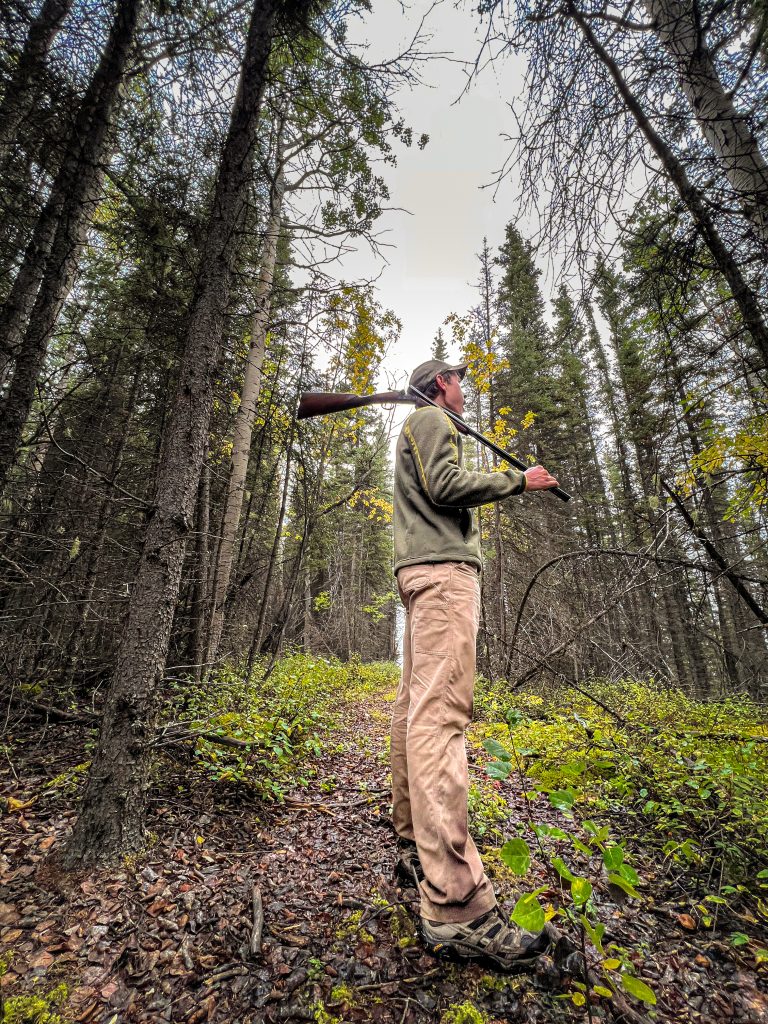Alaska’s true king of the uplands
by Joe Jackson
This is a tale of two spruce grouse, and it begins in mid-September.
The dawn is stingingly cold and the leaves flutter groundward to remind me that another year has passed. I try to ignore the impending winter and focus on the task at hand: a side-by-side shotgun in my grip, a pocket full of shells, a flurry of daydreams filled with hard-flushing grouse. That’s when I came upon the first bird of our story.
He was a doddering male spruce grouse propped stoically in the middle of the trail, his tail fan spread proud as a turkey. I approached carefully. Given the circumstances—him sitting there all innocent, me refusing to shoot grouse on the ground—I decided to let this one go, but not before seeing how close he’d let me get. Each step brought me closer. Finally, as I nearly stepped on his plump avian form, he took to the air in a flurry of wings.
Most Alaskans have had similar encounters with spruce grouse (Falcipennis canadensis); being able to walk within petting distance, getting stuck in “grouse jams” on the road when birds refuse to fly. The prevailing nickname for the spruce grouse is “fool hen,” and while this is an apt description of their often-dim-witted nature, I think the behavior is a function of where they live. Widespread throughout Alaska and Canada, spruce grouse live in places with a consistent scarcity of us. They need old-growth boreal forest that humans haven’t meddled in, and given this preference, they see few people and are generally impervious to our existence.
Another thing about all grouse is that they need gravel for their digestive processes. Their gizzard uses small bits of grit to grind up plant material—and spruce grouse seem especially fond of it. Which means that the birds use our roads, hiking trails, and riverbanks to gather it. We’re usually in a hurry on those paths, while the grouse never seems to be. For us, these encounters elicit a chuckle, followed by an utterance of that loveable sobriquet: “Fool hen.”
You can carry this impression of the birds for the rest of your life and not be wrong, but before you do, let me tell you of another grouse.
In this case, there is no trail. Just boundless boreal. Even though there are several hours of daylight left, it feels like the very edge of night there beneath the spruce boughs. I’ve returned to a favorite hunting spot; a swampy hollow that, for whatever reason—water, variety of tree species, abundance of highbush cranberries—seems to always hold grouse. The shotgun is still in my hands, poised and ready. I only make it one more step before a bird blasts out of there like a missile, maybe 50 yards away. I’m startled to the point of inaction. The gun hangs useless at my side.
You might think that this second grouse was of the ruffed variety—a different species entirely. Dubbed the “king of the uplands” the continent over, the ruffed grouse (Bonasa umbellus) has commanded the devotion of generations of wingshooters for their unpredictable flushes, hard and fast flying, and general roguery. This caginess contrasts sharply with their easy-going spruce cousins.

But no—a quick in-flight identification proves that this is indeed a spruce grouse, a wily old male that obviously knew my intentions and decided to put as many trees between me and him as possible. I catch just a glimpse of his handsome form; pewter-colored feathers broken by deep whites and deep blacks, a wild musket-ball eye capped by a blood-red comb, one regal tail ruddering frantically. Next thing I know, he’s vanished. Bird hunting lore is full of art depicting a ruffed grouse or two surging away from their pursuers, seemingly humbling the men with guns and perpetuating the birds’ lives of mystery. Here, today, it’s a spruce grouse. As sporting a bird as any. Fool hen no more.
I hike back to the truck, empty-handed but not really feeling that way. Spruce grouse have taught me how to hunt, at first with their abundance and obliging nature, and then with their unpredictability once I got the hang of things. Somehow, they knew exactly what I needed.
In a way, I’m indebted to the species, and I’m happy to nurse an abiding fondness for them that will never go away. They may sit on the gravel and refuse to fly; they may live on to get more bad raps from upland hunters and garner more foolish nicknames. Yet somewhere underneath all those feathers, in that beating bird heart, there’s still an infinite capacity to surprise, to make a person love this wondrous state in a million new ways.
That’s a king of Alaska’s uplands in my book.
Joe Jackson has spent the last five years trying to indoctrinate others into his passion for spruce grouse. He’s written for magazines including Alaska, Fly Fisherman, The Drake, The Flyfish Journal, and others. Find him at josephdjacksonwriter.com.


Comments are closed.